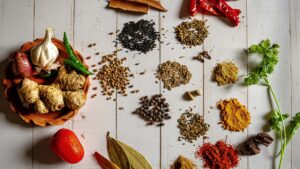The global spice trade is a captivating journey that has shaped cultures, cuisines, and economies for centuries. Spices are more than just flavor enhancers; they are a testament to the rich tapestry of human history and the diversity of our palates. In this exploration of the global spice trade, we uncover the origins, varieties, and culinary delights that have made spices an integral part of our lives.
Origins of the Spice Trade
The spice trade has ancient roots that trace back to civilizations like the Egyptians, Greeks, and Romans. Initially, spices were highly prized for their medicinal properties and preservative qualities. As empires expanded and trade routes were established, spices began to flow across continents.
Varieties of Spices
Spices come in an astonishing array of varieties, each with its unique flavor profile, aroma, and culinary application. Here are some of the most renowned spices from around the world:
- Cinnamon: Originating from Sri Lanka and Indonesia, cinnamon adds warmth and sweetness to both sweet and savory dishes.
- Black Pepper: Known as the “King of Spices,” black pepper is native to India and has a robust, peppery flavor.
- Saffron: Derived from the crocus flower, saffron is one of the world’s most expensive spices, known for its vivid color and aromatic qualities.
- Turmeric: Native to South Asia, turmeric is celebrated for its earthy flavor and vibrant yellow hue, commonly used in curries.
- Cardamom: This fragrant spice hails from India and is used in both sweet and savory dishes, imparting a floral and slightly citrusy note.
- Paprika: Originating from Central America, paprika varies in flavor from sweet and mild to smoky and spicy, offering versatility in cooking.
Culinary Delights with Spices
Spices are the heart and soul of many culinary traditions worldwide. Here are some iconic dishes where spices play a central role:
- Indian Curry: A symphony of spices, curry dishes showcase the complexity and depth of Indian cuisine.
- Mexican Mole: Mole sauces incorporate a blend of spices, chilies, and chocolate to create a rich, savory experience.
- Moroccan Tagine: Tagines use a medley of spices like cumin, coriander, and cinnamon to create aromatic stews.
- Thai Tom Yum: Thai cuisine’s iconic hot and sour soup features lemongrass, galangal, and chili for a vibrant flavor profile.
- Chinese Five-Spice: A blend of star anise, cloves, Chinese cinnamon, Sichuan pepper, and fennel seeds, it adds depth to Chinese dishes.
The Future of the Spice Trade
Today, the global spice trade continues to evolve. Sustainability and ethical sourcing practices are gaining prominence as consumers demand responsibly sourced spices. Additionally, advancements in transportation and communication have made spices more accessible than ever, allowing culinary enthusiasts to explore new flavors and techniques.
The global spice trade is not just about flavor; it’s a journey through history, culture, and the vibrant tapestry of cuisines that make our world rich and diverse. As we savor these culinary delights, we also pay homage to the countless generations that have contributed to the global spice trade’s enduring legacy.





